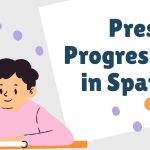Saying ‘Hi’ in Spanish goes beyond just ‘Hola.’ Although ‘Hola’ works everywhere, greetings change with the time of day and where you are.
In the morning, you say ‘Buenos días,’ and in the afternoon, it’s ‘Buenas tardes.’ These phrases show respect and cultural know-how.
But there’s more to it in casual settings or different Spanish-speaking places. You might hear ‘¿Qué tal?’ or ‘¿Cómo estás?’ instead. Getting to know these variations isn’t just about language; it’s about connecting with culture.
It makes you think about how these different greetings reflect deeper social and cultural realities.
how do you actually say “hello” and “hi” in Spanish?
In Spanish, you simply say ‘hello’ and ‘hi’ as ‘Hola’ and ‘Ey.’ These are common ways to start a chat.
‘Hola’ is well-known and works everywhere, whether it’s a formal meeting or hanging out with friends.
‘Ey’ is more laid-back, often used by the young crowd or in casual settings.
Common greetings in Spanish
Spanish has many everyday greetings. Besides the common ‘Hola,’ you can use ‘Buenos días’ in the morning, ‘Buenas tardes’ in the afternoon, and ‘Buenas noches’ at night.
These phrases are a polite way to say hello and show the rich culture of Spanish-speaking places.
- ¡Hola, buen día! – Hello, good day!
- ¡Qué alegría verte! – What a joy to see you!
- ¿Cómo va todo? – How’s everything going?
- ¡Hey! ¿Qué tal? – Hey! How’s it going?
- ¡Saludos desde aquí! – Greetings from here!
- ¡Ey, cuánto tiempo! – Hey, long time no see!
- ¡Hola, compañero! – Hello, mate!
- ¿Cómo te ha ido? – How have you been?
- ¡Qué sorpresa verte! – What a surprise to see you!
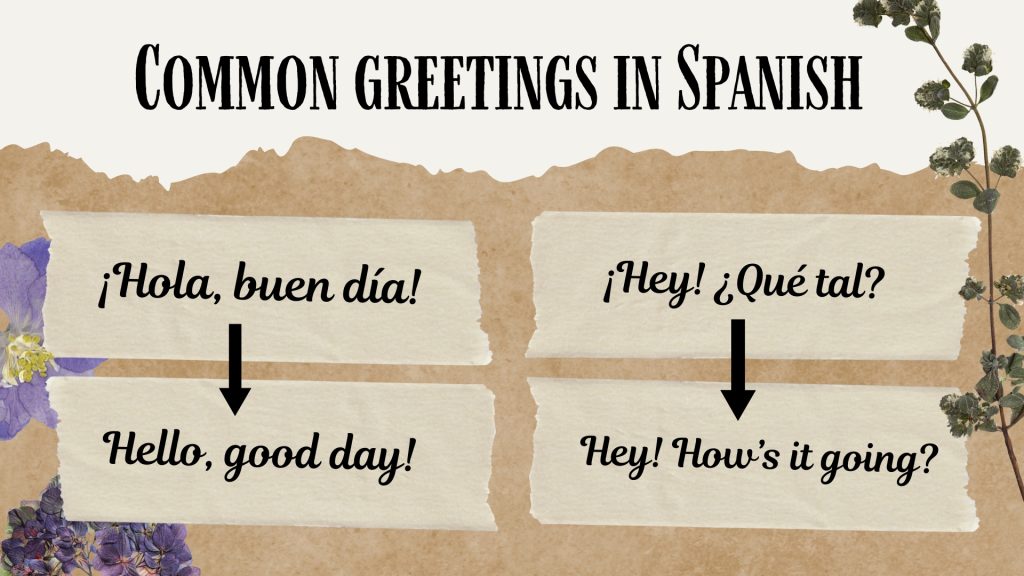
- ¡Un gusto saludarte! – A pleasure to greet you!
- ¡Hola, hola! – Hello, hello!
- ¡Pura vida! – Pure life! (Common in Costa Rica)
- ¿Cómo marcha todo? – How’s everything moving along?
- ¡Salud y buena vibra! – Cheers and good vibes!
- ¡Dime qué hay de nuevo! – Tell me what’s new!
- ¡Espero que estés bien! – I hope you’re well!
- ¡Encantado de verte! – Delighted to see you!
- ¡Bienvenido de nuevo! – Welcome back!
- ¡Un placer encontrarte! – A pleasure to run into you!
- ¡Aquí estamos! – Here we are!
Formal and informal greetings
Knowing when to use formal and informal greetings in Spanish matters a lot. For formal situations, stick to ‘Buenos días,’ ‘Buenas tardes,’ or ‘Buenas noches.’ These are respectful and fit well in professional or formal environments.
On the other hand, if you’re keeping it casual, you can go with ‘Hola,’ ‘Ey,’ or ‘¿Qué tal?’ These are laid-back and great for friends or casual meetings.
Formal Greetings:
- Es un placer verlo. – It’s a pleasure to see you.
- Espero que esté bien. – I hope you’re doing well.
- Le deseo un excelente día. – I wish you a great day.
- Un gusto conocerle. – Nice to meet you.
- Buenos días, ¿cómo ha estado? – Good morning, how have you been?
- Un placer saludarle de nuevo. – A pleasure to greet you again.
- ¿Cómo le ha ido? – How have things been for you?
- Me alegra mucho verle. – I’m very happy to see you.
- Le envío mis mejores deseos. – I send you my best wishes.
- Que tenga una jornada exitosa. – Have a successful day.
- ¡Ey, qué onda! – Hey, what’s up?
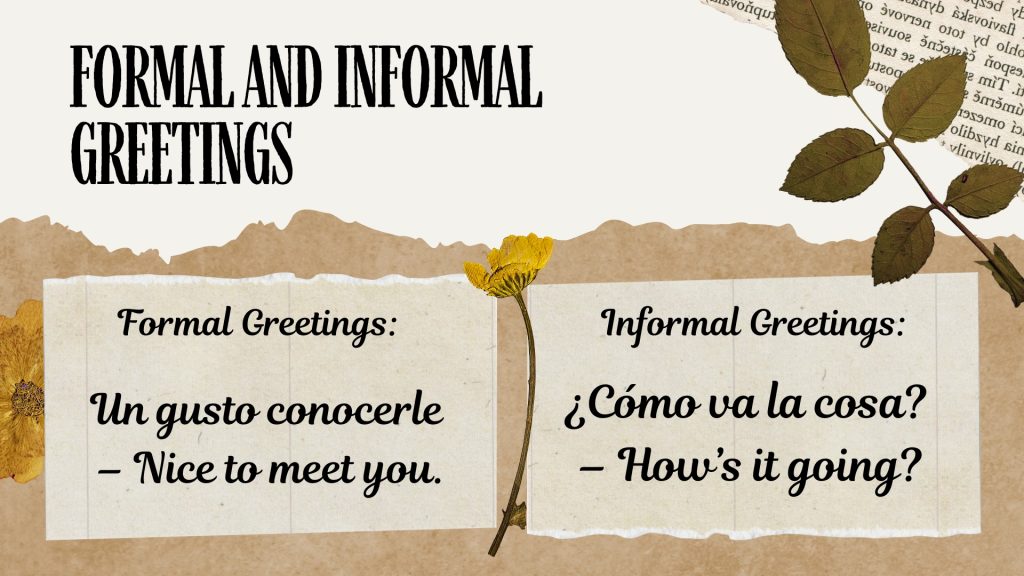
Informal Greetings:
- ¿Qué me cuentas? – What’s new?
- ¡Tanto tiempo sin verte! – Long time no see!
- ¡Hola, amigo/a! – Hey, friend!
- ¡Qué milagro verte! – What a miracle to see you!
- ¡Dime qué hay de bueno! – Tell me something good!
- ¿Cómo va la cosa? – How’s it going?
- ¡Oye, qué tal todo! – Hey, how’s everything!
- ¡Qué buena sorpresa verte! – What a nice surprise to see you!
- ¡Vamos, cuéntame todo! – Come on, tell me everything!
Different Ways to Say ‘You’re Welcome’ – From formal to casual, explore variations of saying ‘You’re Welcome.’ Find Out More
Country-specific greetings
When we look at how people say hello in different Spanish-speaking countries, it’s clear each place has its own style.
In Colombia, you might hear someone say ‘¿Quiubo?’ just to say hi in a relaxed way.
Over in Costa Rica, ‘Pura vida’ is common, and it’s not just a greeting—it’s a way of celebrating life.
In Chile, you might be greeted with ‘Weeena weon/a,’ which is pretty informal.
And in Argentina, ‘Che’ is a popular way to grab someone’s attention or start chatting.
It’s fascinating to see how these simple hellos tell us so much about each place.
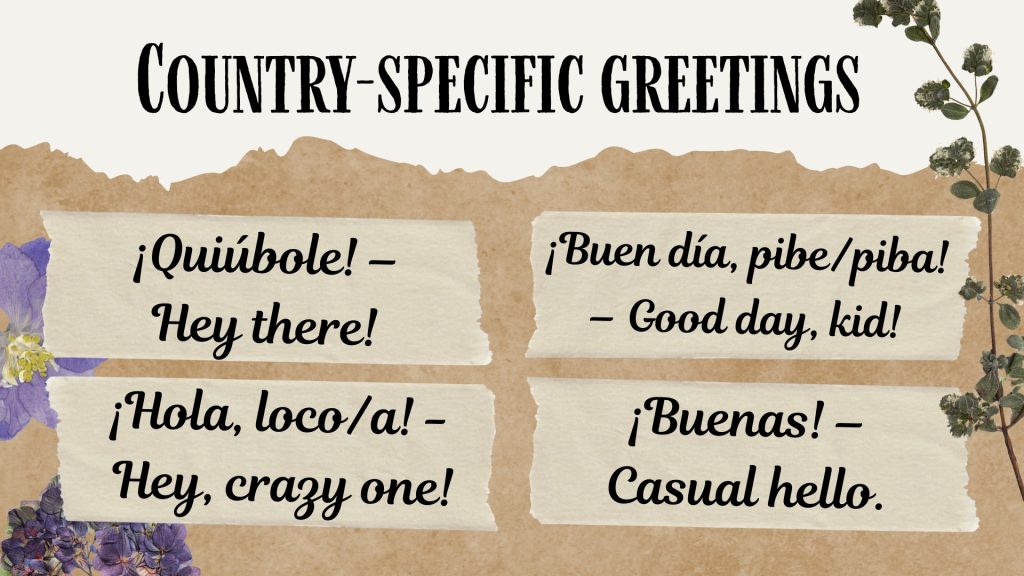
Mexico:
- ¿Qué hubo? – What’s up? (Casual)
- ¿Qué tranza? – What’s up? (Very informal)
- ¡Quiúbole! – Hey there!
- ¡Órale, compa! – Wow, friend!
- ¡Ándale pues! – Alright then!
Argentina:
- ¡Che, cómo andás! – Hey, how are you?
- ¡Boludo/a, qué hacés! – Dude, what’s up? (Very informal)
- ¡Hola, loco/a! – Hey, crazy one! (Friendly)
- ¡Cómo va la cosa, che! – How’s it going, mate?
- ¡Buen día, pibe/piba! – Good day, kid!
Spain:
- ¡Buenas! – Casual hello.
- ¡Hola, tío/tía! – Hey, dude!
- ¿Qué pasa, tronco? – What’s up, mate?
- ¡Ey, colega! – Hey, buddy!
- ¿Cómo lo llevas? – How’s it going for you?
Colombia:
- ¡Quiubo, parce! – What’s up, buddy?
- ¿Cómo va la vuelta? – How’s life treating you?
- ¡Esa es la actitud, socio! – That’s the attitude, friend!
- ¡Saludos, mano! – Greetings, bro!
- ¡Hola, bacano verte! – Hey, cool to see you!
Learn Spanish Through Quotes – Improve your Spanish by understanding and using famous sayings. Start Learning
Morning greetings in Spanish
Switching to Spain’s morning greetings, they mostly say ‘Buenos días’ to each other. This means ‘good morning’ and is used everywhere Spanish is spoken. It fits any time before noon and works in both casual and formal situations.
It’s a simple, polite way to kick off the day.
- ¡Despierta y brilla! – Wake up and shine!
- Que tengas una mañana genial. – Have an awesome morning.
- ¡Feliz amanecer! – Happy sunrise!
- ¡Arriba, el día empieza! – Get up, the day begins!
- ¡Un café y buenos días! – A coffee and good morning!
- ¡Que la luz del día te inspire! – May the daylight inspire you!
- ¡Hoy será un gran día! – Today will be a great day!
- ¡Sal al mundo con energía! – Go out into the world with energy!
- ¡Hola, madrugador/a! – Hello, early bird!
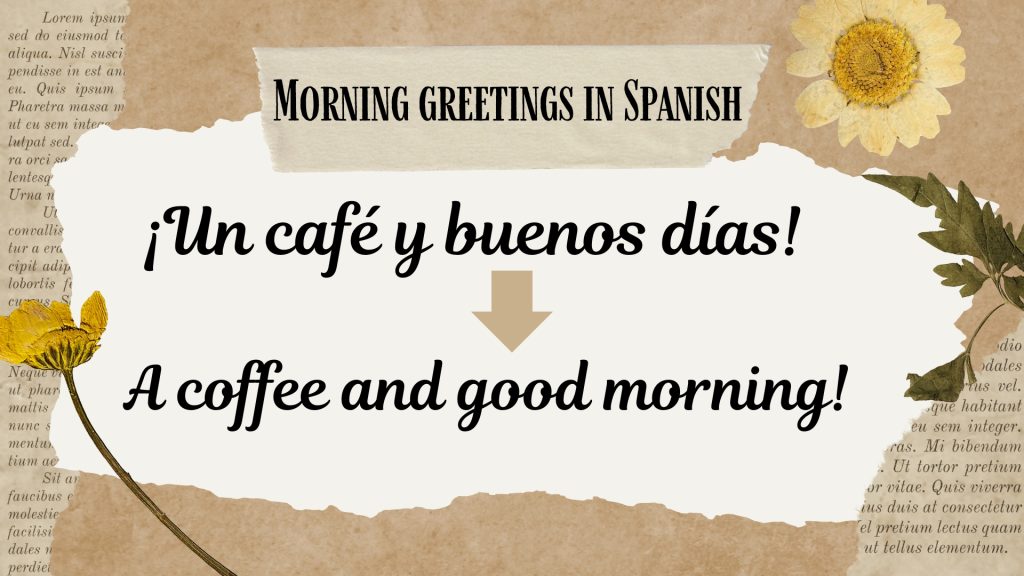
- ¡Día nuevo, oportunidades nuevas! – New day, new opportunities!
- ¡Abre los ojos y sonríe! – Open your eyes and smile!
- ¡Levántate con alegría! – Get up with joy!
- ¡Que este día te traiga suerte! – May this day bring you luck!
- ¡Buenos días, gente linda! – Good morning, beautiful people!
- ¡Que empiece la aventura! – Let the adventure begin!
- ¡Sol radiante, día brillante! – Shining sun, brilliant day!
- ¡Hoy es un buen día para empezar! – Today is a good day to start!
- ¡Hora de sacudir el sueño! – Time to shake off sleep!
- ¡Que el día te sonría! – May the day smile at you!
- ¡No hay mejor forma de empezar el día que con una sonrisa! – There’s no better way to start the day than with a smile!
Afternoon greetings in Spanish
In Spanish, you say ‘Buenas tardes’ to greet someone in the afternoon. It works from noon until sunset.
This phrase means ‘good afternoon.’ You can use it in casual chats or professional meetings.
It’s a polite way to recognize the time of day and show respect at the same time.
- ¡Buenas tardes, que todo fluya! – Good afternoon, let everything flow!
- ¡Espero que estés pasando una gran tarde! – Hope you’re having a great afternoon!
- ¡Qué calorcito! – What nice warmth!
- ¡Hola, qué tal esta tarde! – Hey, how’s your afternoon!
- ¡Tarde de café y amigos! – An afternoon for coffee and friends!
- ¡Saludos soleados de la tarde! – Sunny afternoon greetings!
- ¡Que esta tarde sea tranquila! – May this afternoon be peaceful!
- ¡Buenas tardes, sigue brillando! – Good afternoon, keep shining!
- ¡Cae el sol, pero no la energía! – The sun goes down, but not the energy!
- ¡Momento perfecto para un descanso! – Perfect time for a break!
- ¡Aprovecha la tarde! – Make the most of the afternoon!
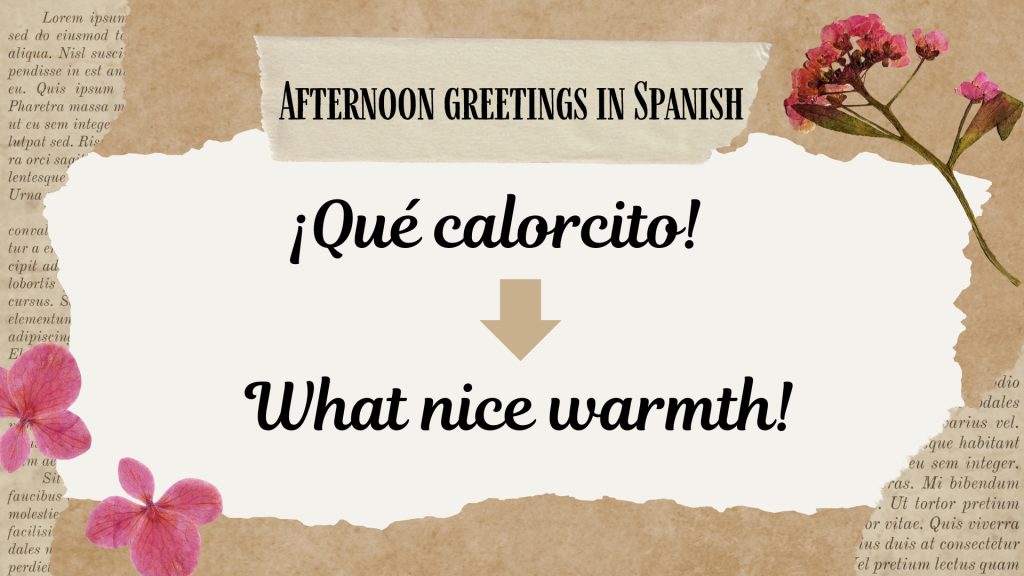
- ¡Ya casi acaba el día, ánimo! – The day is almost over, hang in there!
- ¡Qué hermosa tarde para disfrutar! – What a beautiful afternoon to enjoy!
- ¡A seguir con energía! – Keep going with energy!
- ¡Tarde de éxitos y buenas noticias! – Afternoon of success and good news!
- ¡Que la tarde te traiga paz! – May the afternoon bring you peace!
- ¡Las mejores ideas llegan en la tarde! – The best ideas come in the afternoon!
- ¡Hora del café y la charla! – Time for coffee and a chat!
- ¡A disfrutar el atardecer! – Time to enjoy the sunset!
- ¡Tarde perfecta para seguir soñando! – A perfect afternoon to keep dreaming!
How to answer the phone in Spanish
After talking about how to greet people in the afternoon, let’s look at how to answer the phone in Spanish. People usually say ‘¿Diga?’ or ‘¿Bueno?’ which is like saying ‘Hello?’ It’s friendly and works for most calls.
In places like Chile and Colombia, you might hear ‘¿Aló?’ which also shows you’re paying attention to the person calling.
- ¡Hola, diga! – Hello, speak! (Casual)
- ¿Bueno? – Hello? (Common in Mexico)
- ¡Dígame! – Tell me! (Common in Spain)
- ¡Aló! – Hello! (Used in many Latin American countries)
- ¡Sí, hola! – Yes, hello!
- ¡Oiga! – Listen! (Formal or when unsure who is calling)
- ¿Quién habla? – Who is speaking?
- ¿Qué tal, en qué puedo ayudarle? – How are you, how can I help you?
- ¡Buenas! ¿Con quién hablo? – Hello! Who am I speaking with?
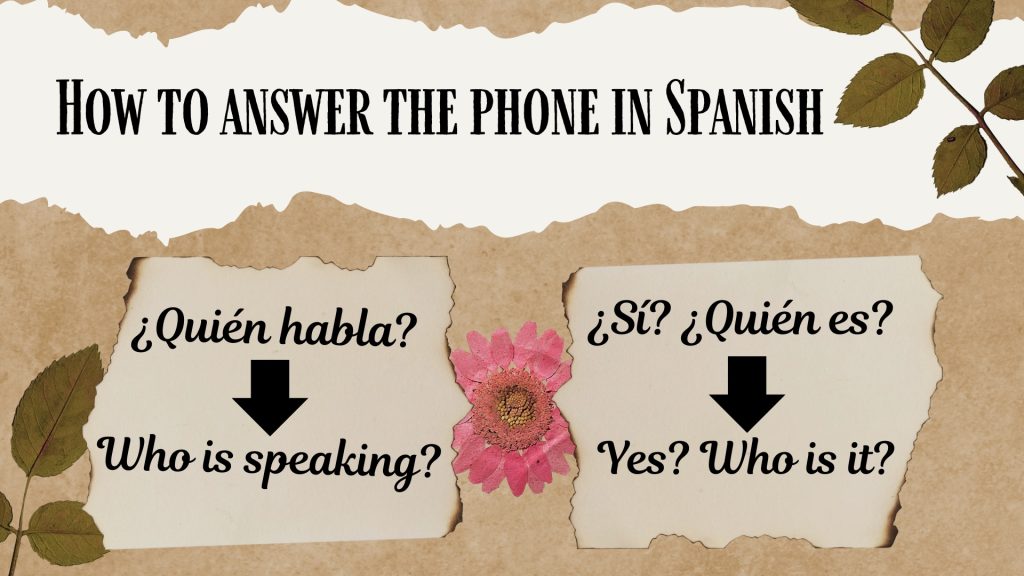
- ¡Hola, a sus órdenes! – Hello, at your service!
- Hable, lo escucho. – Speak, I’m listening.
- ¿Hola, con quién desea hablar? – Hello, who would you like to speak with?
- Le atiende [tu nombre]. – You are speaking with [your name].
- ¡Hola! ¿Cómo puedo ayudarte? – Hello! How can I help you?
- ¿Qué hay de nuevo? – What’s new? (Informal)
- Gracias por llamar, ¿en qué puedo servirle? – Thanks for calling, how can I assist you?
- ¡Diga, soy yo! – Speak, it’s me! (Familiar)
- ¿Sí? ¿Quién es? – Yes? Who is it?
- Hola, oficina de [nombre de empresa]. – Hello, [company name] office.
- ¡Hola! ¿Todo bien? – Hello! Everything okay?
Conclusion
To put it simply, knowing how to say hello in Spanish can really improve your ability to communicate and connect with others. ‘Hola’ is casual, while ‘Buenos días,’ ‘Buenas tardes,’ and ‘Buenas noches’ are more formal and depend on the time of day.
Each greeting has its place, depending on who you’re talking to and where. Also, different areas have their own ways of saying these phrases, which can give you a glimpse into their culture. Getting these right helps you speak respectfully and effectively with Spanish speakers everywhere.
Online Learning Platform – Access high-quality language lessons from Lingua Viva.
Dayron is co-owner, and the heart of Lingua Viva. He is a licensed Educator and Interpreter with 15+ years of experience, and holds a graduate degree in Foreign Language Instruction. A native Caleño who creates a comfortable environment for his students. Dayron is loved by all and inspires confidence in his students when learning and speaking Spanish. He is also an avid comedian that loves to dance salsa.


